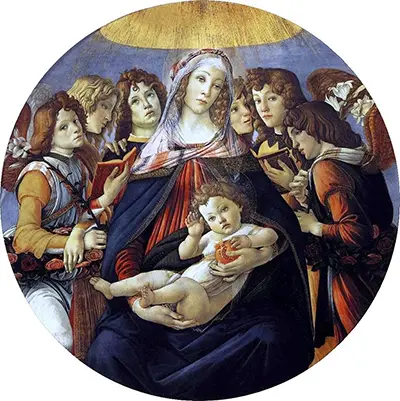 Buy Art Prints Now
Buy Art Prints Nowfrom Amazon
* As an Amazon Associate, and partner with Google Adsense and Ezoic, I earn from qualifying purchases.
Madonna of the Pomegranate is a beautiful tondo from Early Renaissance artist, Sandro Botticelli
A tondo is a round painting, of which Botticelli completed several during his career. They were very common during the Renaissance era but certainly much less so now.
This particular painting is dated at circa 1487. Many of Botticelli's paintings and drawings have not been dated precisely as little documentation is available on his specific artworks.
Madonna of the Pomegranate is very typical of Botticelli's career in that there are multiple layers of symbolism, some impressive portraiture and also the familiar theme of the Madonna. Religious input can be seen across his career, but most towards the end.
This tempera on panel has a 143.5 cm diameter and is yet another of his works that is now housed in the world-famous Uffizi in Florence. His career is well represented here in both number of artworks and also range of mediums, with some fine sketchwork to see too.
Madonna of the Magnificat was another tondo by this artist, probably his best known and features a similar composition to that seen here. Madonna of the Pomegranate has perhaps more faded colour though this may be more about the conservation techniques used on the two artworks, rather than their original design.
Tondos have been around since well before even the Early Renaissance, Masaccio produced Birth Tray around 1427 and Putto and a Small Dog at around the same time. Michelangelo's Holy Family with St John and Doni Tondo are perhaps the two most famous Renaissance tondos.
The Pomegranate, as used in multiple paintings, represents Christ's suffering through the abundance of seeds found in the fruit. Artist Botticelli would typically tinker with his angels before settling on a finished composition. Their positions in relation to the key focus of the painting was always something that took time and perhaps study sketches on occassion.




